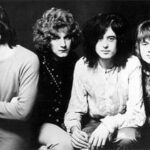New Order’s third album Low-life is their most evenly brilliant effort to date. While Power, Corruption and Lies featured extraordinary highlights such as “Age of Consent”, “586”, “The Village” and “Your Silent Face” it also suffers from containing New Order’s only virtually unlistenable song “We All Stand”.
Low-life, by contrast, features solid techno-rock from beginning to end. The album is also notorious for it covers, which features album-sized, distorted, black & white visages of the band members. Like many things connected with New Order albums, this is a sort of inside joke.
New Order’s first two albums, as well as their two albums when they were known as Joy Division before the suicide of lead singer Ian Curtis, were legendary for the lack of information. No lyric sheet, no linter note, not even much in the way of letting consumers know who had recorded it. New Order is the most consistently anti-commercial band of all time-much more so than the more celebrated Nirvana.
It was this thumbing of noses in the face of traditional expectations that led to this renowned cover. After some nudging by the suits in charge to make themselves more accessible and give the band a face, New Order responded with a cover that consists of nothing but faces. And that’s literally true: The inside sleeve featured two more close-ups and no information. However, New Order did apparently agree to make one concession toward the mainstream: Low-life was the first album accompanied by a single that was actually culled from the album. Previously, New Order had released 12 inch singles that were not included on the album.
Every single New Order album opens with a classic and Low-life is definitely no exception, kicking off with one of the all time greatest New Order songs of all time, “Love Vigilantes.” At first it seems that this album will eschew the movement toward a synth-based sound that Power, Corruption and Lies signaled. This song launches four count drum beat before the guitars crash the party and the band is off on one of their few political statements. The song-at the time of Low-life New Order was still writing songs that didn’t include the title anywhere within it-is a first person recounting of a soldier’s return from war, only to find that he is a ghost. “Love Vigilantes” should be required at any anti-war rally these days. It is truly heartbreaking while also being one of the few genuinely kick-ass rock songs the band ever recorded.
This stunning beginning is followed immediately by the shorter album version of “The Perfect Kiss.” The 12-inch single of this song features three different versions with the longer version of the original being quite simply right up there alongside “Blue Monday” and “Temptation” as the epitome of New Order’s music. But even the truncated version found on the album is more than worthwhile.
New Order is about music more than they are about lyrics and while one misses the soaring keyboards and pounding rhythm that takes the extended version to heights not reached by the album version, one also misses the extra vocals that were added to the single. But enough about the single, this is a review of the album and “The Perfect Kiss” is such a perfect song that you can’t go wrong with it. A side note: The video for “The Perfect Kiss” was directed by Jonathan Demme, several years before he would win an Oscar for The Silence of the Lambs.
“The Perfect Kiss” betrays the opening salvo’s promise of moving away from the synthesizer, but while Power, Corruption and Lies often seems to be all synth and no guitar, with this album New Order proved they had mastered the combination of both. And the next song “This Time of Night” is even more proof of that than “The Perfect Kiss.”
Another terrific drum intro leads into a brilliantly labyrinthine and strangely ominous synthesizer-driven song that is intermittently punctuated by slices of guitar. As singer Bernard Sumner sings the appropriately cryptic lyrics, the song suddenly is taken over by one of the few uses of a piano in New Order’s discography. It almost sounds as if someone is in the shadows, idly banging away one key at a time. Then the synth pops back in with a swirling rhythm that drives the song to its climatic finale.
The finale of what was Side 1 back when it was released as an album begins with a moaning synth sound that is soon joined by a short guitar solo before all the other instruments slice in together to form one of the tightest rock songs ever by recorded by New Order. This song is one of the finest examples of how Peter Hook’s bass often carries the melody of a New Order song. Since Hook first appeared on the scene, this sound of a bass-driven melody isn’t quite as it was when he first adopted it out of pure necessity. You’ll hear it in songs by The Killers, for instance.
But Peter Hook and New Order did it first and do it better. “Sunrise” almost loses its tightness at one point as it seems as if every member of the band tries at once to break loose and go off on their own. Bernard appeals for communication in his uncharacteristically emotional delivery until finally the songs winds down, almost as if running out of energy, unable to go on any longer.
As I mentioned earlier, New Order is a band that is much more concerned with music than lyrics. Unlike their initial incarnation when they could rely on the almost too painful to listen to lyrics of Ian Curtis, New Order is more concerned with sound than getting any kind of message across. One of the trademarks of their 12 singles was that there would be a minute or two of instrumental music before the lyrics even kicked in. Almost every one of their albums features an instrumental, but none as beautiful as “Elegia.”
This haunting song is an example of how until their next album, Brotherhood, there always seemed to be the shadow of Ian Curtis hanging over them. There isn’t anything to necessarily suggest this idea either lyrically or-in the case of “Elegia”-musically, but just as the video of “The Perfect Kiss” has a mysterious figure in shadows watching over the recording session that one certainly has the reasonable right to suggest is symbolic of Ian Curtis, there was always something in the first three albums that made it seem as if they still hadn’t quite said their final goodbye to their late band mate.
Elegia” has such a haunting quality to it, that it has been used in several films, including the Oscar-nominated short subject More, Pretty in Pink, an American Masters documentary on Truman Capote, and an episode of CSI. Incidentally, my wife and I used it at our wedding, despite having to move it up by several hours due to the threat of Hurricane Elena.
“Sooner Than You Think” is another textbook example of how the band uses Peter Hook’s signature bass style to drive a song. Combining tight drumming and some more nifty waves of synthesizer, the song features one of my favorite goofy New Order lyrics:
Your country is a wonderful place
It pales my England into disgrace
To buy a drink that is so much more reasonable
I think I’ll go there when it gets seasonable
Every time I hear that lyric I can’t help but wonder to which foreign country he’s referring.
The next to last song on the album is the most joyously synth-based song on the album, the only one that sounds like it could have been on Power, Corruption and Lies. I’m not a big fan of the 12 inch version of “Subculture” and prefer the album version in this, unlike with “The Perfect Kiss.” This is pure synth-crazy New Order at its best and it is recommended you listen to this through headphones, turned way up so that you can hear Bernard’s signoff to the song: “Baby!”
The album ends with “Face Up” and it probably ranks as the best signoff in New Order album history. (Although the hilarious lyrics of “Every Little Counts” from Brotherhood is a close second.) The song opens with a nice synthesizer solo accompanied by a chorus not unlike that found in “Blue Monday” and some more wicked guitar slices before it moves into a full blown guitar-heavy song throughout the first stanza.
During the course of the song, however, the song changes tack, sometimes highlighting Stephen Morris’ drumming, sometimes showcasing Gillian Gilbert’s synthesizer skills, sometimes showing off Bernard’s guitar playing. And then everything comes back together. This is a manically upbeat song that is offset by some downbeat phrases.
If called upon to choose New Order’s best album, this would be my pick. It’s a difficult thing to do because, with the exception of Get Ready, any album they put out has a shot at being chosen the best. But since this is the only album on which there isn’t a single misstep at all, since this album is flawless and contains more great music than the greatest hits albums of most other bands, it is my opinion that Low-life must be considered the peak long-form accomplishment for a band that is usually noted more for being a great singles band. It belongs on anyone’s list of essential albums.




